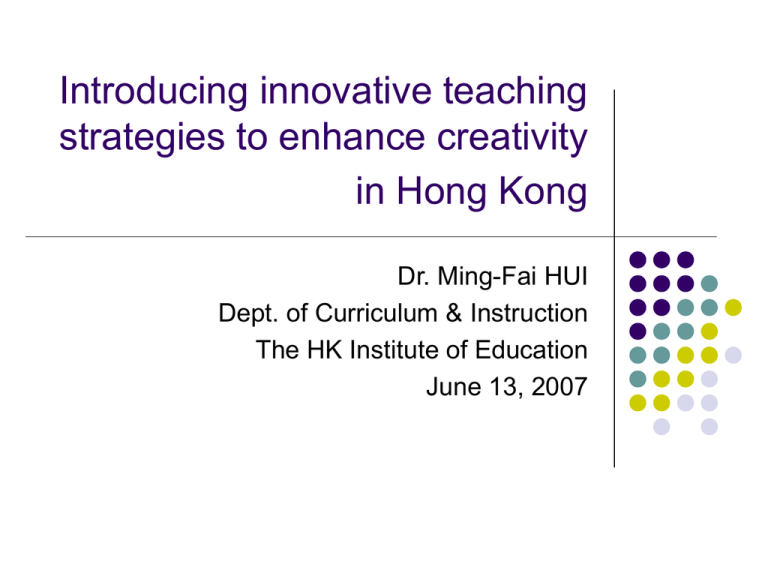Teachers interested to try in the future for the 20 teaching strategies
advertisement

Introducing innovative teaching strategies to enhance creativity in Hong Kong Dr. Ming-Fai HUI Dept. of Curriculum & Instruction The HK Institute of Education June 13, 2007 Education Reform Nine generic skills The 3 Cs The cultivation of creativity becomes one of the major educational goals in the current reform Teachers are encouraged to contribute new ideas to teaching, infuse thinking skills into the curriculum and nurture students ability to think creatively Creativity in the Classroom Teachers are expected to act as: - a facilitator - a stimulator - a mentor - a model - a performer - an idea generator 20 Creative Teaching Strategies Put oneself in role 角色想像 Playfulness and humor 幽默趣談 Forced connections 強廹組合 Group dynamics 團體接力 Imitate and re-construct 模仿再造 Analogy 類推比喻 Use all senses 感觀並用 Abstract to concrete / concrete to abstract具體/ 抽象化 Construct fictitious plot 虛構情節 Explore the challenge 好奇探索 20 Creative Teaching Strategies Idea association through images 圖像聯想 Game interpretation 遊戲演繹 Grasp essence from complexity 設題摘要 Modify and alter for elaboration 修訂變換 Hypothesize and imagine 假設想像 Object probe 實物推想 Problem-solving 問題解決 Tolerance of ambiguity 容忍爭議 Deferred judgment 延遲判斷 Experiment and discover 測試發現 20 Creative Teaching Strategies Modified from Williams’ (1970) teaching model showing18 teaching strategies effective for fostering students’ creative behaviour Modified from Lin’s (1997) 18 teaching methods for creative writing These proposed strategies have been modified and adapted to cater for the regular classrooms in HK Introduced to teachers taking my module, “The Creative Teacher and Creative Teaching Strategies” Using the Strategies in HK Schools Very few teachers know what they are Even if they do, they rarely practice them in teaching their subjects They blame it on too much emphasis on examinations – learning hard facts are more important then generating ideas, especially original ideas They do not see the merits and long-term effects that stimulate active involvement of students Teachers’ preferences to teaching strategies for fostering creativity A questionnaire survey was conducted to two classes of the Creativity course in 2005/06 Entire sample (n=40) was stemmed from the inservice primary and secondary school teachers with subject specialization: English (n=15) Chinese (n=8) Mathematics (n=6) Home Econ (n=2) General Studies (n=1) Physical Ed (n=1) Music (n=1) Visual Arts (n=3) Science (n=1) Economics & Public Affairs (n=2) Findings: Teachers’ preferences on strategies most effective for fostering creativity - Teachers were asked to name 3 out of 20 strategies based on their teaching experiences that they think would best foster the creative thinking processes or products of student learning Construct fictitious plot (32%) Forced connections (28%) Idea associations through images (25%) Findings: Teachers interested to try in the future for the 20 teaching strategies - Teachers were asked to name 3 out of 20 strategies based on their teaching experiences that they would be interested to try in the classroom: Object probe (60%) Forced connections (55%) Playfulness and humour (45%) Findings: Teachers interested but lack of knowledge and skills to try from the 20 teaching strategies - - Teachers were asked to name 3 out of 20 strategies based on their teaching experiences that they would be interested to try in the classroom, but need training: Deferred judgment (47.5%) From abstract to concrete or from concrete to abstract (45%) Tolerance for ambiguity (45%) Findings: Teachers not interested to try from the 20 teaching strategies - Teachers were asked to name 3 out of 20 strategies based on their teaching experiences that they would NOT be interested to try in the classroom: Modify and alter for elaboration (12.5%) Grasp essence from complexity (10%) Group dynamics (10%) Discussion on Findings of Study To my delight, the 3 most effective teaching strategies selected by teachers who attended my courses have very distinctive characteristics of their own. - Idea associations through images Forced connections Constructing fictitious plot From there, we need to contemplate on the contexts of the educational system and school culture of Hong Kong where these teachers belong. Teaching Strategy 1: Idea Association through Images This strategy enables students to use their divergent thinking to think of many different responses in a given situation. The situation is normally revealed as an image like a picture, cartoon, drawings or any moving images projected on the screen. These images are searched and displayed by the teacher as a point of departure to trigger students’ divergent thinking, imagination, and transference of learning. Teachers are devote even a short time for class preparation can get remarkable results in student learning. Visuals are thought-provoking because concrete images can stimulate mental images to facilitate learning. Guided imagery can enhance students’ memory and stimulate their writing or other creative expressions Teaching Strategy 2: Forced Connections This strategy enables students to face two un-related concepts, ideas, actions or phenomena together. Students learn to define and redefine problems posing on them. When two unrelated elements are put together, many possibilities may occur. Students will think of this problem in a new and useful way. Teachers provide unrelated names, incidences, concepts or situations for students to link up into something meaningful. Students learn to be flexible, imaginative. This strategy compel them to think and create new solutions. This concept of “press” or restrictions in time, space and conditions tend to be the most convenient way for teachers to implement in the classroom. Teaching Strategy 3: Construct Fictitious Plot This strategy enables students to make up a story that is open for possibilities. Teachers should cover the basic content materials before assigning students to open-ended tasks. Sufficient time to ponder is important. Teachers may think that there is nothing substantial to prepare before the lesson. However, experienced teachers find that to make such a strategy effective, they have to go through the assignment with a “fictitious plot” themselves. This is often neglected by Hong Kong teachers themselves. With such findings, teacher educators may examine their programme and focus more on introducing and modeling the strategies indicated by servicing teachers to be most effective, strategies that they are interested to try in the future, strategies that they like to try but lack of knowledge and skills, and find out why they express no interest in learning some of the strategies.






